Research at the Institute for Nuclear Physics centers on the structure and the interaction of elementary particles, especially on the understanding of the so-called strong force and its implications on nuclear and particle physics.
The Mainzer Microtron MAMI, an electron accelerator for energies of up to 1,6 GeV, is the core of experimental investigations. Additionally, scientists at the Institute of Nuclear Physics are working on the theoretical description and interpretation of the experimental results and of external experiments in, for example, Beijing (IHEP), Darmstadt (GSI) and Geneva (CERN).
Current news – FB 08 – Kernphysik (eng)
 We congratulate Mr. Martin Müller on the successful completion of his dissertation entitled
We congratulate Mr. Martin Müller on the successful completion of his dissertation entitled
"Design, Implementation and Commissioning of the Readout and Control Systems for the Mu3e Experiment"
Martin Müller has defended his PhD on the data acquisition system for Mu3e. He has developed firmware for synchronizing the detector at the few picosend level, configuring thousands of pixel chips with hundreds of millions of tune values in a few seconds and was instrumental in getting Mu3e DAQ systems running in labs across Europe. He has also contributed decisively to many beam tests and the Mu3e cosmic and integration runs.
New method to produce an extremely heavy hydrogen isotope at the Mainz Microtron accelerator MAMI
Production and measurement of the extremely neutron-rich hydrogen isotope ⁶H achieved for the first time in an electron scattering experiment / Result shows stronger than expected interaction between neutrons within the nucleus
30 April 2025
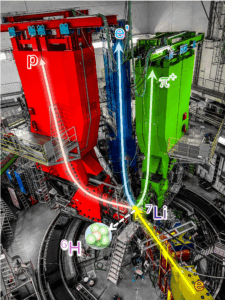
The A1 collaboration at the Institute for Nuclear Physics at Johannes Gutenberg University Mainz, together with scientists from China and Japan, has for the first time successfully produced one of the most neutron-rich isotopes, hydrogen-6, in an electron scattering experiment. The experiment at the spectrometer facility at the Mainz Microtron (MAMI) particle accelerator presents a new method for investigating light, neutron-rich nuclei and challenges our current understanding of multi-nucleon interactions. “This measurement could only be carried out thanks to the unique combination of the excellent quality of the MAMI electron beam and the three high-resolution spectrometers of the A1 collaboration,” comments Prof. Dr. Josef Pochodzalla from the Institute for Nuclear Physics. Researchers from Fudan University in Shanghai (China), Tohoku University Sendai, and the University of Tokyo (both Japan) were involved in the experiment. The experimental work was led by doctoral student Tianhao Shao and has been published in the renowned journal Physical Review Letters.
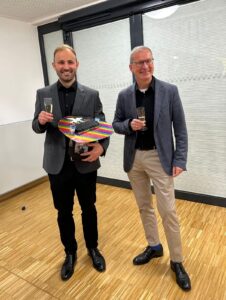 We congratulate Dr. Sebastian Stengel on the successful completion of his dissertation entitled “Design and Development of the MAGIX Trigger Veto System”
We congratulate Dr. Sebastian Stengel on the successful completion of his dissertation entitled “Design and Development of the MAGIX Trigger Veto System”
In his dissertation, Sebastian Stengel developed, implemented, and tested a central detector system for the MAGIX experiment at the new electron accelerator MESA in Mainz.
The versatile MAGIX experiment is designed for high-precision investigations in nuclear and hadron physics, but also opens up other opportunities, including searches for so-called dark photons – hypothetical particles closely related to theories of dark matter. The detection of scattered particles is primarily achieved via two high-resolution magnetic spectrometers.
The focus of the work was the so-called trigger veto system of these spectrometers. It provides a fast and reliable trigger decision for data acquisition, records timing coincidences, and delivers crucial information for particle identification. In addition, it serves as a time reference for the readout of the spectrometer tracking detectors.
The system consists of a segmented trigger layer made of plastic scintillators read out by photomultipliers, as well as a flexible veto system composed of additional scintillator layers equipped with silicon photomultipliers and lead layers for background suppression. The readout is handled by a fast, high-rate FPGA-based electronics system.
Throughout the course of the work, all components of the system were designed, selected, tested, and systematically optimized – including the mechanical design for integration into the spectrometers. Both extensive simulations using Geant4 and comprehensive system tests under realistic experimental conditions were employed.
During a beam time at the MAMI accelerator, the trigger system achieved a remarkable detection efficiency of 99.93%, a time resolution of approximately 180 ps (FWHM), and a spatial resolution of about 25 mm – significantly surpassing the original design requirements. The system is now fully operational and ready for use in the upcoming MAGIX experiment.
The dissertation was carried out within the framework of the MAGIX Collaboration under the supervision of Prof. Achim Denig and impressively documents Sebastian Stengel’s contribution to the preparation of one of the key experiments at the MESA accelerator.
This work stands as an outstanding example of comprehensive, modern experimental detector development – from the conceptual phase to the successful implementation of a complex and high-performance detector system.
Scientists from the PRISMA+ Cluster of Excellence are involved in a major international research project searching for "new physics"
15 April 2025
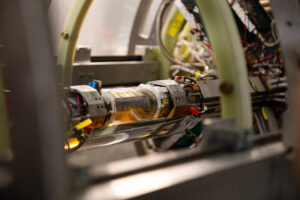
The German Research Foundation (DFG) has extended its funding for the Mu3e experiment for another four years. The project, which is a collaboration of Johannes Gutenberg University Mainz (JGU), Heidelberg University, and the Karlsruhe Institute of Technology (KIT), will receive funding of EUR 5.6 million starting in May 2025. This extension of the DFG-funded Research Unit 5199 will enable the participating scientists to take further steps in the search for the violation of the lepton family number.
The Mu3e experiment, carried out at the Paul Scherrer Institute (PSI) in Villigen in Switzerland, is an international project which also involves researchers from Switzerland and the UK. The aim of the project is to observe a so-called lepton-flavor violating decay of a positive muon, in which the muon decays into two positrons and one electron. As this decay is not foreseen in the Standard Model of particle physics, the observation of this process would be a clear indication of new physics.
 We congratulate Dr. Viacheslav Tsaran on completing his dissertation entitled
We congratulate Dr. Viacheslav Tsaran on completing his dissertation entitled
Unified approach to nuclear pion scattering and photoproduction
A promising way to study how protons and neutrons are arranged inside atomic nuclei is by creating neutral pions through photon interactions with the nuclei. However, accurately modeling these interactions has been challenging. This research develops a new theoretical framework for pion production that accounts for the complex interactions between pions and nuclei.
Superconducting core component for international P2 experiment installed in underground hall at a depth of ten meters
25 November 2024
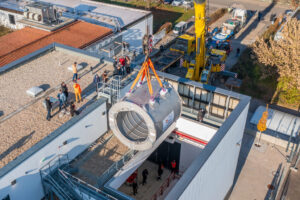
One of the flagship projects of the PRISMA+ Cluster of Excellence at Johannes Gutenberg University Mainz (JGU) is the construction of the new energy-recovering particle accelerator MESA (Mainz Energy-recovering Superconducting Accelerator), which will enable experiments with unprecedented precision in the future. One of the main experiments at MESA, P2, will play a key role in researching the "new physics" – physics beyond the Standard Model of particle physics – by measuring the so-called weak mixing angle. The central component of the P2 experiment, a superconducting magnet coil with a diameter of four meters and a weight of 21 tons, has now been delivered to the JGU campus and installed in the MESA particle accelerator. The magnet was manufactured in Vannes, France, and delivered to Mainz last Thursday. "We have been working together with the company SigmaPhi for almost five years to overcome the challenges and implement the state-of-the-art design for our experiment," said Professor Frank Maas, spokesperson of the P2 experiment, which is currently being set up by a collaboration of physicists from Germany, France, Canada, and the USA.
"Such a solenoid magnet is being used for experiments of this kind for the first time. Its large diameter makes it possible to record particularly high particle rates. However, the size of the magnet also posed a particular challenge in terms of design and production."
 We congratulate Marius Köppel on the completed dissertation entitled
We congratulate Marius Köppel on the completed dissertation entitled
"Data Flow in the Mu3e Data Acquisition System"
Marius Köppel has defended his PhD on the data acquisition system for the Mu3e experiment at PSI. Mu3e searches for the lepton-flavour-violating decay of a positive muon to two positrons and an electron. Marius has developed firmware for the data flow out of the detector to the filter farm and was instrumental to get the data acquisition and online analysis for the Mu3e integration and cosmic runs up and running. He has also contributed decisively to establishing the Mu3e MuPix pixel sensors as a tool for muon spin relaxation (MuSR) experiments. The thesis is available here.
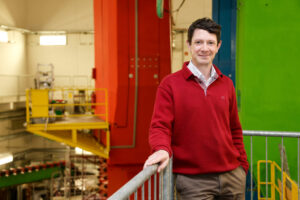 Major award for theoretical physicist of Mainz University and member of the PRISMA+ Cluster of Excellence
Major award for theoretical physicist of Mainz University and member of the PRISMA+ Cluster of Excellence
8 October 2024
Pierre Capel, Professor of Theoretical Physics at the Institute for Nuclear Physics of Johannes Gutenberg University Mainz (JGU) and member of the PRISMA+ Cluster of Excellence, has been elected a Fellow of the American Physical Society (APS). This honor recognizes his careful and creative application of few-body methods to the study of nuclear reactions involving exotic nuclei. The APS Fellowship Program was established to recognize outstanding members who have made significant advances in physics through original research and publication. It is a distinct honor that signifies recognition by professional peers. Each year, no more than 0.5 percent of APS members are elected to the Fellow status.
Collaborative Research Centre at JGU's Institute for Nuclear Physics seeks new physical phenomena through a better understanding of strong interaction processes
31 May 2024
The German Research Foundation (DFG) today approved the establishment of a new Collaborative Research Centre (CRC) at Johannes Gutenberg University Mainz (JGU). The CRC 1660 "Hadrons and Nuclei as Discovery Tools" aims to understand the strong interaction that leads to processes involving hadrons, nuclei, and atoms. The goal is to answer fundamental questions: What physical phenomena occur beyond the Standard Model of particle physics (SM) and how can we measure and describe them? The spokespersons of the new Collaborative Research Centre are Professor Concettina Sfienti (experiment) and Professor Marc Vanderhaeghen (theory) from the Institute for Nuclear Physics at JGU.
24.05.24
 From 13th to 17th may the workshop for Strange hadrons as precision tool for strongly interacting systems (SPICE) took place in Trento. “With 52 international participants and 39 keynote speakers, the conference offered a perfect platform to assess the present status of the field, to identify potential synergies within the community and to define experimental objectives for new cutting-edge research activities” Prof. Josef Pochodzalla, one of the organizers, resumes. To cover the field as broadly as possible a variety of topics were addressed during the five days workshop, including hypernuclei, exotic atoms, femtoscopy, extreme neutron rich nuclei, the kaon-nucleus interaction and the
From 13th to 17th may the workshop for Strange hadrons as precision tool for strongly interacting systems (SPICE) took place in Trento. “With 52 international participants and 39 keynote speakers, the conference offered a perfect platform to assess the present status of the field, to identify potential synergies within the community and to define experimental objectives for new cutting-edge research activities” Prof. Josef Pochodzalla, one of the organizers, resumes. To cover the field as broadly as possible a variety of topics were addressed during the five days workshop, including hypernuclei, exotic atoms, femtoscopy, extreme neutron rich nuclei, the kaon-nucleus interaction and the  strangeness in neutron stars.
strangeness in neutron stars.
The workshop was supported by the EU Strong 2020 project and ECT*.

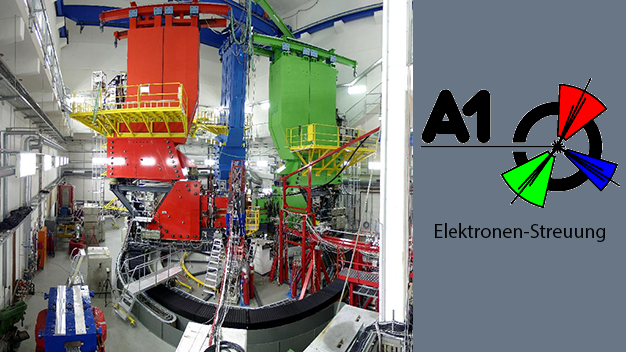




 Major award for theoretical physicist of Mainz University and member of the PRISMA+ Cluster of Excellence
Major award for theoretical physicist of Mainz University and member of the PRISMA+ Cluster of Excellence